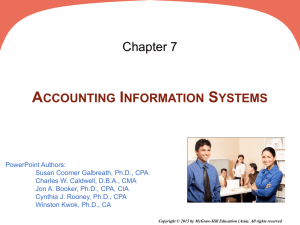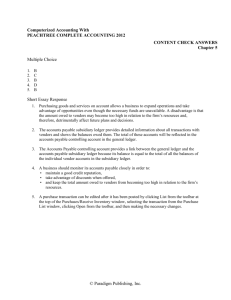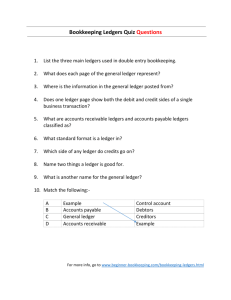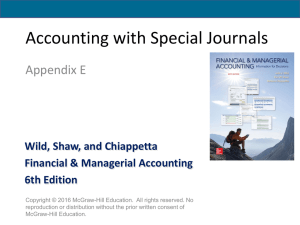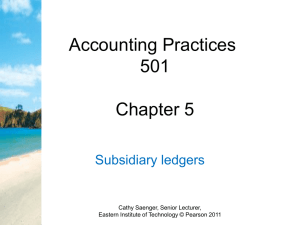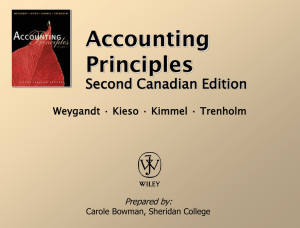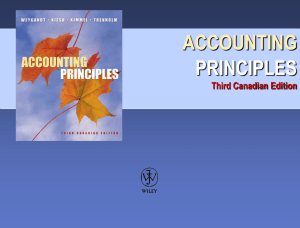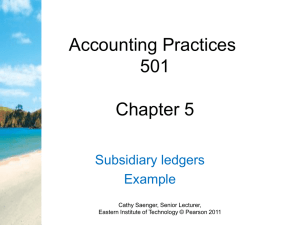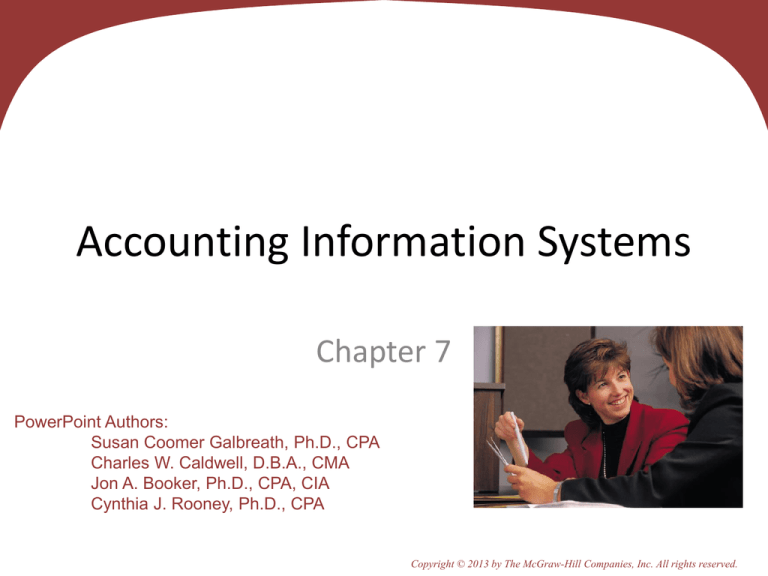
7-1
Accounting Information Systems
Chapter 7
PowerPoint Authors:
Susan Coomer Galbreath, Ph.D., CPA
Charles W. Caldwell, D.B.A., CMA
Jon A. Booker, Ph.D., CPA, CIA
Cynthia J. Rooney, Ph.D., CPA
Copyright © 2013 by The McGraw-Hill Companies, Inc. All rights reserved.
7-2
C1
Fundamental System Principles
Accounting
information
systems collect
and process data
from transactions
and events,
organize them in
useful reports,
and communicate
results to
decisions makers.
7-3
C1
Components of Accounting Systems
Increasingly, source documents are
electronic files creating a “paperless”
system.
•Keyboards
•Scanners
•Modems
•Bar-Code Reader
•Hardware
•Software
•Professional Judgment
7-4
C1
Components of Accounting Systems
•Printer
•Monitor
•Projectors
•Web communications
•CD/DVD
•Hard Drive
•Tape
•Paper Document
7-5
C2
Special Journals in Accounting
7-6
C3
Subsidiary Ledgers
Characteristic
Controlling
Account
Subsidiary Ledger
Amounts due
from customers
Accounts
Receivable
Accounts Receivable
Ledger
Amounts owed
to creditors
Accounts
Payable
Accounts Payable
Ledger
Subsidiary ledgers are a listing of individual
accounts with common characteristics.
7-7
C3
Accounts Receivable Ledger
After all items are posted, the balance in the accounts receivable controlling account is
equal to the sum of the balances in the accounts receivable subsidiary ledger.
7-8
P1
Sales Journal
7-9
P2
Proving the Ledgers
A schedule of
accounts receivable
lists each customer
and the balance
owed.
The balance of the Accounts Receivable controlling
account in the general ledger should equal the accounts
in the accounts receivable subsidiary ledger.
7 - 10
P1
Sales Taxes
Governmental agencies often
require sellers to collect sales
taxes from customers and to
periodically send these taxes
to the appropriate agency.
7 - 11
P1
Sales Returns and Allowances
If a company has few sales returns, they may
be recorded in the General Journal.
A company with many sales returns may use
a Sales Returns and Allowances Journal.
7 - 12
P1
Cash Receipts Types
1. Cash from credit
customers
2. Cash from cash
sales
3. Cash from other
sources
7 - 13
P1
Footing, Crossfooting, and Posting
7 - 14
P1
7 - 15
P2
Proving the Ledger
A schedule of
accounts payable
lists each supplier
and the balance
owed to them.
The balance of the Accounts Payable controlling
account in the general ledger should equal the
accounts in the accounts payable subsidiary ledger.
7 - 16
P1
7 - 17
P1
General Journal Transactions
Adjusting
Entries
Closing
Entries
Purchase
Returns &
Allowances
Sales
Returns &
Allowances
7 - 18
Computer Technology in Accounting
Off-the-Shelf Software
Familiar accounting
programs such as
Peachtree® and
QuickBooks® are
designed to be user
friendly and menu
driven.
Integrated Software
Actions taken in one
part of the system
automatically affect
related parts. For
instance, when a
credit sale is entered,
several parts of the
system are
automatically
updated.
7 - 19
Data Processing in Accounting
Online processing enters and
processes data immediately.
Batch processing accumulates
information for a period of
time and then processes all the
data at one time (daily, weekly,
or monthly).
7 - 20
Computer Networks in Accounting
Server
Work Stations
Computer networks are links among computers
giving different users access to common
databases and programs.
7 - 21
Enterprise Resource
Planning Software (ERP)
Programs that manage and integrate a
company’s vital operations.
7 - 22
Cloud Computing
Cloud computing is the delivery of computing as
a service rather than a product.
Laptop
Cell Phone
Cloud
Computing
Computer
Tablet
Cloud computing uses applications via the Web instead
of installing them on one's own computer.
7 - 23
Global View
Systems Principles and Components
Both U.S. GAAP and IFRS aim for high-quality financial reporting.
System principles and components are fundamentally similar
across the globe. However, culture and other realities often mean
different emphases on the mix of system controls.
Special Journals
Accounting systems for recording sales, purchases, and cash
receipts and disbursements are similar worldwide. Systems that
employ special journals are applied worldwide. Further, the basic
structure of special journals as explained in this chapter is one
means to company efficiency.
7 - 24
A1
Segment Return on Assets
A good AIS collects financial data for a
company’s various segments.
Companies Reporting Operations
by Segments
A segment is a part of a
company that is
separately identified by its
products, services, or
geographic market.
*Total exceeds 100% because companies can report more
than one segment.
7 - 25
A1
Segment Return on Assets
Segment return
on assets
=
Segment operating income
Segment average assets
Callaway Golf Company reports that it operates in
two business segments: (1) golf clubs and (2) golf
balls. The golf club segment shows a higher return
on assets.
7 - 26
End of Chapter 7

